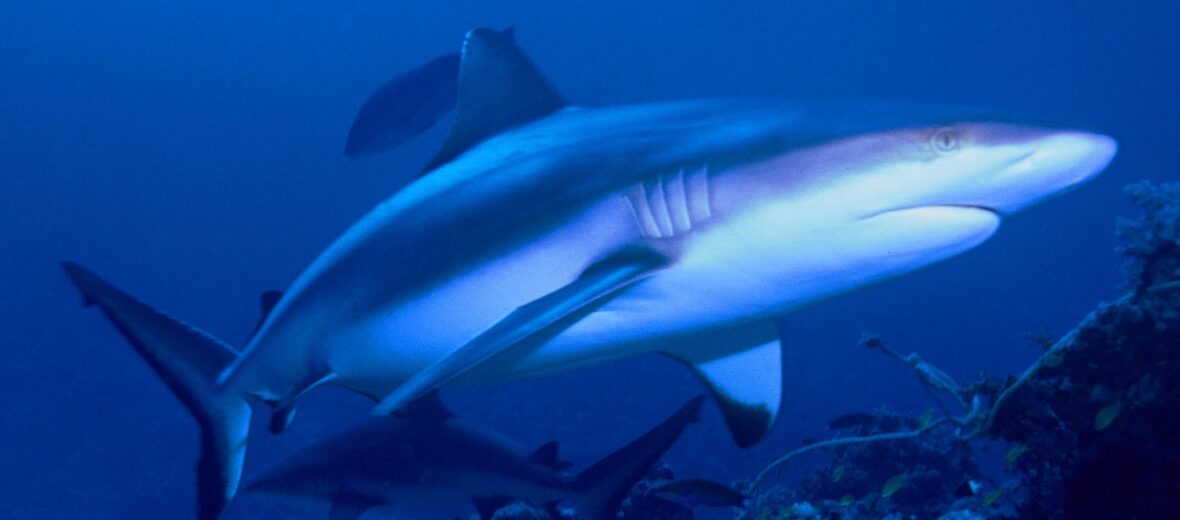
The grey reef shark is a commonly seen shark in the Pacific and Indian Oceans, as well as in the Caribbean Sea. They prefer reefs, but can also be found in lagoons and even in the open sea. Unfortunately, they face the threats of habitat destruction at the hands of residential and commercial developments, as well as aquaculture; overfishing; recreational activities that interfere with their way of life; and climate change (which causes rising sea temperatures that effect their food source and cause coral bleaching – which also depletes their food supply and alter their habitat). These sharks are listed as Endangered by the IUCN and their numbers are decreasing.
First the Stats…
Scientific name: Carcharhinus amblyrhynchos
Weight: Up to 66 lbs.
Length: Up to 6.2 feet
Lifespan: Up to 25 years
Now on to the Facts!
1.) Grey reef sharks are requiem sharks (migratory, live-bearing sharks from warm seas that also include other sharks like bull sharks, lemon sharks, and blacktip reef sharks).
2.) They can dive up to 3,300 feet, but tend to stay closer to the surface at about 200 feet.
3.) These sharks are aggressive but social amongst each other. They can form shoals of up to 20 individuals.
4.) A group of sharks is called a college, frenzy, gam, grind, herd, shiver, or shoal.
5.) Grey reef sharks are cathemeral (active during the day and night), with peak activity occurring at night.
But wait, there’s more on the grey reef shark!
6.) Female grey reef sharks are viviparous. This means the mother nourishes her embryos through a placental connection and the sharks are born live, not hatched from external egg cases.
7.) Females undergo up to a 14 month gestation (pregnancy) and birth up to 6 pups every other year.
Did you know…?
The grey reef shark can reach speeds of up to 25 mph.
8.) Fish, crustaceans, squid, and octopuses are all on the menu.
9.) Having an extremely acute sense of smell, they can detect 1 part tuna extract in 10 billion parts of sea water!
10.) Their only predators are larger sharks and humans.
But wait, there’s more on the grey reef shark!
11.) When threatened, these sharks will swim side to side with an arched back, raised head, and dropped pectoral fins. This posturing is meant to thwart their attacker’s attempts of making a meal out of the reef shark.
12.) The female sharks often swim in shallower water. It is presumed that this is due to the fact that warmer sea water speeds the development of their young in utero. The shallower water may also help to thwart advances by males.
Did you know…?
In 2006, Robbins et al. found that grey reef shark populations in the Great Barrier Reef fishing zones had declined by 97% compared to no-entry zones (boats are not allowed).
13.) They tend to be curious of divers and will often approach quite closely. They tend to lose interest on subsequent dives.
14.) These sharks are also known to engage in feeding frenzies that can be quite dangerous and even deadly for smaller specimens.
15.) The grey reef shark is often captured by fisheries to meet the demand for shark fin soup and fishmeal. This, along with their slow birth rate, make it an increased challenge to avoid extinction.
Now a Short Grey Reef Shark Video!
Be sure to share & comment below! Also, check out the Critter Science YouTube channel. Videos added regularly!
Want to suggest a critter for me to write about? Let me know here.
Some source material acquired from: Wikipedia & IUCN
Photo credit: Albert kok



